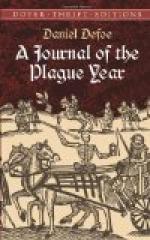That all public feasting, and particularly by the companies[90] of this city, and dinners in taverns, alehouses, and other places of public entertainment, be forborne till further order and allowance, and that the money thereby spared be preserved, and employed for the benefit and relief of the poor visited with the infection.
Tippling-Houses.
That disorderly tippling in taverns, alehouses, coffeehouses, and cellars, be severely looked unto as the common sin of the time, and greatest occasion of dispersing the plague. And that no company or person be suffered to remain or come into any tavern, alehouse, or coffeehouse, to drink, after nine of the clock in the evening, according to the ancient law and custom of this city, upon the penalties ordained by law.
And for the better execution of these orders, and such other rules and directions as upon further consideration shall be found needful, it is ordered and enjoined that the aldermen, deputies, and common councilmen shall meet together weekly, once, twice, thrice, or oftener, as cause shall require, at some one general place accustomed in their respective wards, being clear from infection of the plague, to consult how the said orders may be put in execution, not intending that any dwelling in or near places infected shall come to the said meeting while their coming may be doubtful. And the said aldermen, deputies, and common councilmen, in their several wards, may put in execution any other orders that by them, at their said meetings, shall be conceived and devised for the preservation of his Majesty’s subjects from the infection.
Sir
JOHN LAWRENCE, Lord Mayor.
Sir
GEORGE WATERMAN, }
Sir
CHARLES DOE, } Sheriffs.
I need not say that these orders extended only to such places as were within the lord mayor’s jurisdiction: so it is requisite to observe that the justices of peace within those parishes and places as were called the “hamlets” and “outparts” took the same method. As I remember, the orders for shutting up of houses did not take place so soon on our side, because, as I said before, the plague did not reach to this eastern part of the town at least, nor begin to be violent till the beginning of August. For example, the whole bill from the 11th to the 18th of July was 1,761, yet there died but 71 of the plague in all those parishes we call the Tower Hamlets; and they were as follows:—
Aldgate, 14 { 34 { 65
Stepney, 33 The next { 58 To { 76
Whitechapel, 21 week was { 48 Aug. 1 { 79
St. Kath. Tower.[91] 2 thus: { 4 thus: { 4
Trin. Minories,[92] 1 { 1 { 4
— —– —–
71 145 228
It was indeed coming on amain, for the burials that same week were, in the next adjoining parishes, thus:—




